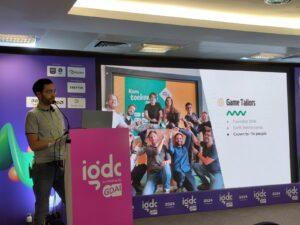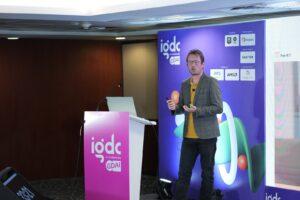Olivier Hokke from GameTailors and Rob Tieben from Games for Health went on a trade mission to India GDC. Did they find that there is a market for digital educational games in India? Learn all about their experiences in the reports they wrote.
 Olivier Hokke from GameTailors says; “With over 1.4 billion people, India’s educational needs are immense. When the DGA invited speakers for the India GDC, we were initially skeptical—expanding from the Netherlands to India felt like skipping a few steps on the global expansion ladder. Nevertheless, with Rob Tieben from Games for Health, I traveled to explore opportunities.
Olivier Hokke from GameTailors says; “With over 1.4 billion people, India’s educational needs are immense. When the DGA invited speakers for the India GDC, we were initially skeptical—expanding from the Netherlands to India felt like skipping a few steps on the global expansion ladder. Nevertheless, with Rob Tieben from Games for Health, I traveled to explore opportunities.
From the VIP mixer onward, the warmth and openness of the Indian people stood out. Networking was effortless, with many enthusiastic about educational games and their potential. Companies like Eduisfun and PlayAblo are making strides, and despite challenges faced by Byju’s, opportunities abound.
India’s challenges—language barriers, pollution, health concerns, and skill mismatches—highlight the need for innovative solutions like game-based learning. Over 750 million Indians have smartphones, offering a vast audience for digital education.
Cities like Bangalore are hubs of talent and innovation. Collaborating with local experts is key, and the Netherlands Business Support Offices (NBSO) provide invaluable connections.
Thanks to DGA, NBSO, and IGDC for this opportunity. With India’s growing interest in educational games, now is the perfect time for game professionals to explore India’s market.”
—
 Rob Tieben from Games for Health: “Scale and impact have been my focus in the last eight years. My aim is to make one billion people happier and healthier using the power of playful and social interactions. Learning more about India seemed like an interesting opportunity, so I was grateful when the DGA, NBSO and IGDC invited me to speak at the India Game Developer Conference (IGDC) in Hyderabad. India seemed for me to be a logical market for scaling, but I was uncertain about impact. Can our solutions, such as a family support program or a citizen science game, make direct positive impact in India?
Rob Tieben from Games for Health: “Scale and impact have been my focus in the last eight years. My aim is to make one billion people happier and healthier using the power of playful and social interactions. Learning more about India seemed like an interesting opportunity, so I was grateful when the DGA, NBSO and IGDC invited me to speak at the India Game Developer Conference (IGDC) in Hyderabad. India seemed for me to be a logical market for scaling, but I was uncertain about impact. Can our solutions, such as a family support program or a citizen science game, make direct positive impact in India?
The answers were surprisingly different from my expectations. Three days of visiting the IGDC taught me a lot. First of all: scale is not what I always thought it was.
A lot of things are massively different in India. A startup apologized to me, for having ‘only’ 8.000.000 users after six months. For our citizen science game to find a cure for cancer, a publisher offered to start a pilot with ‘just’ 100.000 patients. And the answer to my worries, such as ‘are there people in India that want to play a game to find a cure for cancer?’, was: ‘Of course, it’s India. If only a tiny part of our population likes that, it still are hundreds of thousands of people.
That massive scale already partially answered my impact question.
Most people in India, I have learned, are highly motivated to learn and improve in their personal and professional life. Vitality, healthy living and adherence are hot topics: all people I met talked about family members that should and want to change their behaviour, and about the challenges to keep motivated. Clearly, a massive opportunity for cooperation, and a massive market for applied games and playful and social interactions.
What surprised me is the impact that the Indian people had on me. My partner is from India, so I already have very positive experiences with Indian culture, family and community. Even though, I was amazed by the sheer level of curious, motivated and energetic people at the IGDC.
For example, a quarter of the audience at my talk happened to have a background in medicine and ICT, so you can imagine the in-depth questions I got after presenting a medical citizen science game.
Students and professionals on the exhibition floor literally cornered me, not only wanting to learn about me, but sharing hours of concrete advise, connections and immediate tasks for making our solutions a success in India.
The quality of the games, and of the students’ competencies, impressed me as well: our Dutch students could and should learn a lot from working with Indian students.
Last but not least, the international audience at the IGDC was amazing. Everyone seemed to be here, and willing to learn and share.
I have left India with inspiration, hope, motivation and enough valuable connections for at least three years. I have learned more than I taught and thought. I will certainly go again next year, for a longer period, and also visit the hospitals, schools and pharmaceutical companies in the Hyderabad region.
I wholeheartedly invite you to participate – let me know if you are interested!
I thank DGA, NBSO, IGDC and all the amazing people for making it the most inspiring conference visit in many years.”
